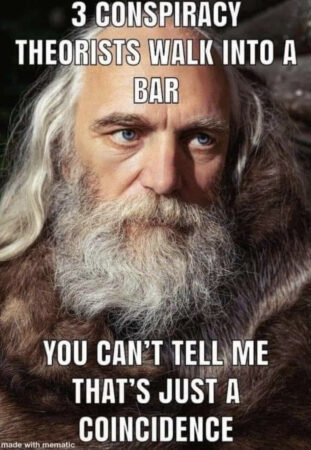Introduction

In today’s installment, I do not wish to address any particular conspiracy theory. Rather I want to talk about the conspiratorial mindset. This is a mindset that results in a particular method of reasoning, and it is a method that is prevalent enough these days for us to start making some noise about it. It is a method of reasoning that is starting to act like the frogs of Egypt.
It is a method that is shared by those who promulgate their views in this way, and by those who buy into those views that were advanced on this basis. And it is not rational.
So my topic today has to do with a particular method of conspiratorial reasoning in public, and please take my use of the word reasoning lightly. I am not addressing the content of any conspiracies themselves—whatever goes on behind closed doors, or on the remote island of a Bond supervillain, or in the inner chambers of the Brethren of the Third Eye.
Full Disclosure
Moreover, I want to conduct this discussion only after I have laid certain cards out on the table. If you were to gather up a list of topics that were usually dismissed as “conspiracy theories” over the last ten years, I actually think that a number of them were plausible, and others of them have now been confirmed as fact. Once a conspiracy theory has come true, it needs to hand in its nutter papers, and head off to its new home in the history books. Thus the lament you have seen in certain insightful memes: “I need some more conspiracy theories. All of mine have come true.” Or, “‘Mommy, what’s the difference between a conspiracy theory and fact?’ ‘About six months, dear.'”
So I am not saying that all of such theories are false, or that all of them are true. I am saying that whether or not they are true, those arguing for them need to step up their game. They need to stop reasoning in a way that can best be described as “taking several hits of epistemic acid and then free associating.”
The second point is this. All of us lean a particular way; we all have our biases. This is something we should all be aware of, and as we examine the facts and evidence, we should not allow those biases to make us distort the evidence before us in any dishonest way. That said, one of my biases is a tendency to be sympathetic to anyone designated by the commies as an international pariah. I acknowledge this to be true—but biases don’t have the authority to override the evidence of the facts. So enough about Israel.
The dots themselves are the facts. The connecting of the dots may or may not be evidence, depending on whether or not this conspiratorial method is repudiated.
Connecting the Dots Back in Third Grade
Perhaps you remember this exercise from third grade. You were given a list of new vocabulary words, and the assignment was to make up a story using those new words. The key phrase here is “make up a story.”
For a simple example, three of the words might be house, dog, and cat. Two of the sentences produced could have been “It had started to rain, and so both the dog and the cat wanted to be let into the house.” On the other hand, it also could have been, “After the fire started, the dog and cat bolted from the house.”
Both sentences used the same three words, but the two sentences are not part of the same story. They do not inhabit the same world. In one world, the dog and cat want into the house, and in the other they want out. Moreover the houses are in two completely different states, and one of them is gray and the other white. The dogs are even different, as well as the cats. What the stories have in common are those three words.
Now Thoreau bequeathed some wisdom for us: “Some circumstantial evidence is very strong, as when you find a trout in the milk.” Or, if we needed to find another example, suppose you found an turtle on top of a fence post. Okay.
The reality of such facts indicates that something is up. But the trout in the milk merely requires us to believe that someone put it there, not that Netanyahu did.
Two Can Play This Game
In what follows, I am making no suggestions, implications, veiled insinuations, or anything like that. This is a reductio ad absurdum that illustrates that this methodology of “dot connecting” for the purpose of simply “raising questions” is pernicious and destructive. It can be aimed in any direction whatever. In short, I am not saying that Candace Owens was involved in the plot to take Charlie Kirk’s life.
Remember the importance of that word not in the previous sentence. But I am saying that if this methodology is a sound one, then someone should check into it. But it is not a sound method. Everything between brackets is a reductio, and not what I am asserting. Got that?
[In any tightly-woven plot, the importance of deflection is crucial. For one example, you recall that immediately after Charlie was shot, there was a man who was initially detained because he was loudly claiming responsibility—doing so in order to give the real shooter additional time for getting away. That was a distraction. He was not the shooter but his behavior was calculated to help the shooter.
Now when Tyler Robinson was apprehended, the prima facie evidence against him was strong. I mean location, rifle, parental ID, and so on. Not only so, but he also fit the profile—in spades—of the kind of person who would do such a thing. He was a hard leftist, and a furry in a relationship with transitioning dude. He was a denizen of the world in which murdering people in order to “stop the hate” makes good sense to them. He fit the profile. So everything about the murder fit neatly into the “that figures” category, and red state America nodded together. Figures.
So why, in the immediate aftermath of the arrest of Tyler Robinson would Candace Owens start questioning the official narrative? When all of normal America was turning on crazed leftists with a mixture of astonishment and disgust, what could be the possible motive for suggesting that they actually didn’t do it? What would we think if, right after Pearl Harbor, when all of America was gearing up for war against Japan, an influential someone started to argue that Canada was behind the attack. How hard would it be for Canadians to paint red circles on their airplanes? If this were to happen, one possibility would be that the person arguing this was in the pay of Japan.
Robinson was arrested on September 11, and the arrest was announced the following day. Within days, Candace started questioning the official narrative, casting shade on the charges against Robinson. But why would she want us to start looking suspiciously at the Mossad, or the federal government, or even dark forces within Turning Point itself?! Clearly this effort of hers is a distraction. Trump’s house cleaning clearly has not yet gotten to the deep state forces in the CIA who want to draw attention away from their asset Taylor Robinson.
You see, the cat and the dog were part of a conspiracy to burn down the house. Few know this.]
When someone is reasoning like this, the only thing that makes any of it even remotely plausible is the size of their platform. If your platform is big enough, you can be as reckless as you want.
Charlie and Israel
One of the facts that some have made much of is the text thread where Charlie—the day before he was shot—was lamenting the fact that a Jewish donor had pulled a $2M donation because he didn’t like the fact that Tucker was invited to speak at AmericaFest.
Remember Occam’s razor. The simplest explanation is likely the best. As I am discussing it here, it is really counterproductive to bring in foreign intelligence agencies, or treachery deep within TPUSA, or a mysterious dark-haired Russian beauty with a sultry voice who talked the shooter into it.
When Charlie was here in Moscow for Man Rampant, we were able to talk a little bit about Israel. I think it is pretty obvious that over the last two years, Charlie was clearly moving in more of a Reformed direction. His background was the evangelicalism of a dispensational variety, and so he was consequently well-acquainted with Christian Zionism, and a lot of his Christian support came from that quarter. And the last time we talked, a few weeks before he died, a central theme of that conversation was presuppositional apologetics—another Reformed distinctive. I mention this simply to say that to move away from a dispensational theology of Israel, which Charlie might well have been doing, is not logically connected at all to a support for Israel as a significant part of the West—which he was passionate about defending.
As am I.
But remember Occam’s razor. Whether Charlies was growing away from dispensational assumptions does not require him to say that some of these donors live down to the stereotypes, and that he might be forced away from the “pro-Israel” position. According to Josh Hammer, Charlie was simply frustrated and blowing off steam. For example, later that day Charlie convened a Zoom call in which he was taking on counsel from Christians and Jews about how best to answer questions about Israel, as his campus tour was beginning the next day in Utah.
So without discounting the possibility that Charlie was just blowing off steam, I think there is another element that should not be ruled out. Charlie was nothing if not a builder of coalitions—his Turning Point project was a remarkable example of a big tent approach that was not the moderate and squishy middle kind of big tent. Nevertheless, it was a big tent, meaning that some in the tent really didn’t like others who were in the tent. When building an operation like that, there are times when you need to cajole some of them, and different times when you need to play hard ball with others of them. One plausible way to interpret that text thread is this . . . Charlie needed that $2M and Jewish backers needed TPUSA to remain solidly pro-Israel. And to not invite Candace, for pity’s sake. Now . . . who needed what they needed more?
Some critics will say that now I am connecting my own dots. Not really. I am suggesting a possible interpretation of events, and am doing so in a way that is not alleging that any particular person is complicit in deeply disturbing evil. So there you go.

